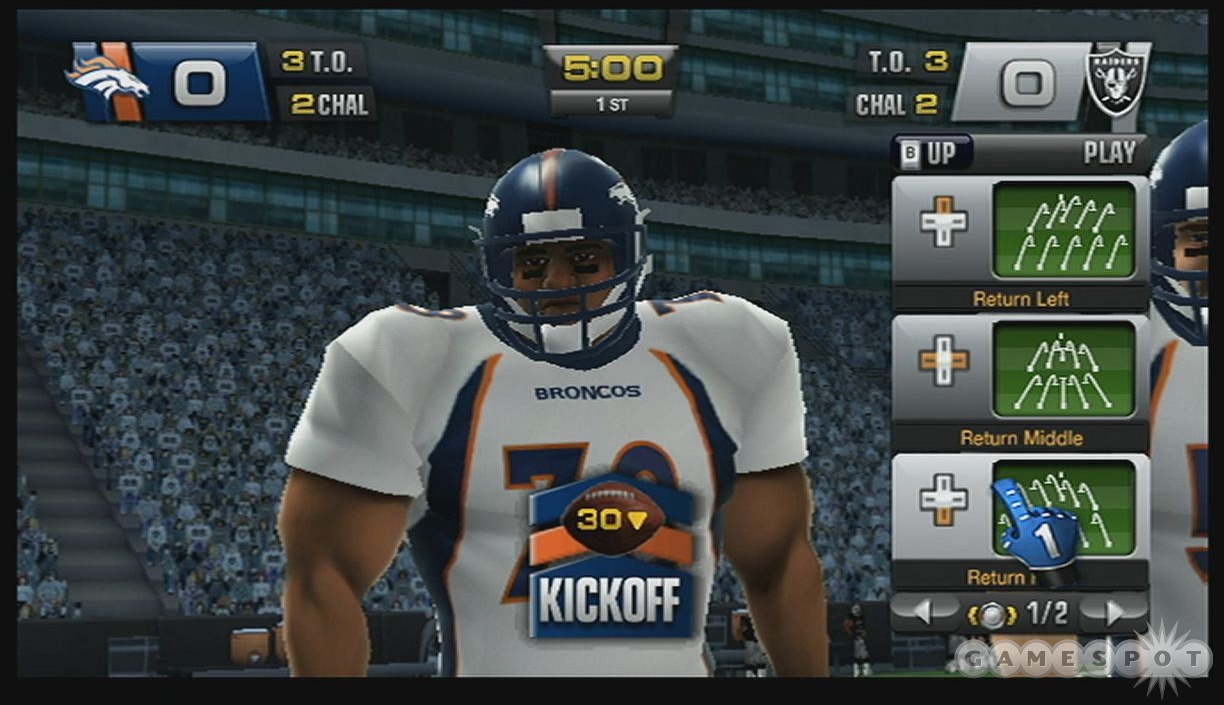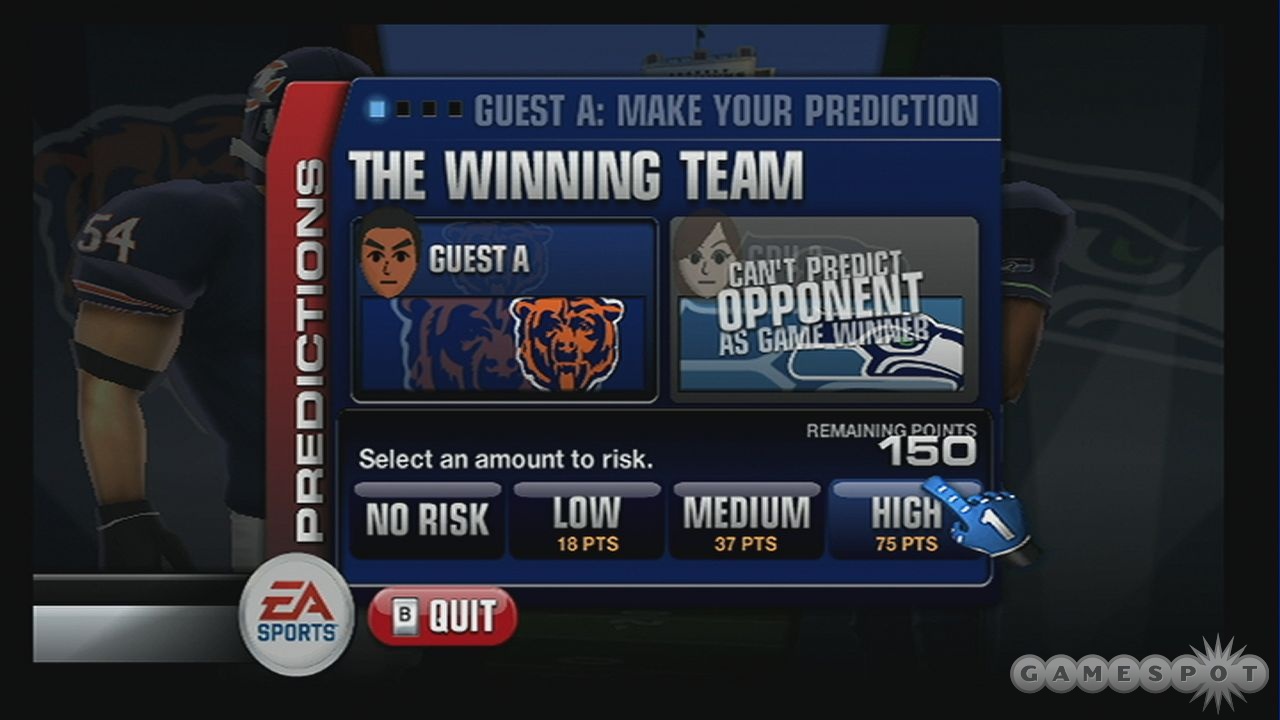Madden NFL 10 for the Wii continues the trend introduced by last year's game of crafting a football experience that's geared toward the Wii and its control setup. Therefore, it delivers some familiar options, including the All Play control scheme that pares the traditional Madden controls down to a single button and some motion control. Madden 10 pushes this approach even further, not just by introducing new gameplay modes that are meant to capitalize on the inherent multiplayer appeal of games on the Wii, but also by crafting a look that fits better with the lighthearted theme of the game. The result is an experience that's fun the first few times around--provided you can consistently play with friends--but lacks the longevity to keep football fans coming back.
That's partly because the traditional mainstay Madden modes, like Franchise and Superstar, still haven't received much attention, if any at all. In fact, they use the same interface and mechanics as previous iterations of Madden on the Wii, so they don't reflect this year's philosophy of making features more Wii specific. What's even more curious is that these modes aren't available off the bat and have to be unlocked, no matter if you want to build up a franchise over the course of the season or create a rookie who has to prove himself and climb through the ranks, you have to either work for it.
It seems like an odd move for any football game to hide typically prominent and more in-depth modes in the background, but maybe not as much for Madden NFL 10 for the Wii--the simple reason being that there's a clear emphasis on playing with other people in the pick-up-and-play modes instead of engaging in the solitary experience of worrying about trade deadlines, injuries, or salaries. But if there's any single mode that's comparable to something like a franchise mode without the aforementioned details (aside from the franchise option itself), it's the Road to the Super Bowl mode.
This mode lets you play a full season, a half season, or just the playoffs with local players cooperatively, and the idea is for you and other players on your team to play as well as possible throughout the season to earn points (rewarded for gaining yards, making catches and tackles, or scoring touchdowns) and avoid being benched during a game. Players get benched when an arrow on a colored bar located next to their Mii falls into the red, but you can get them off the bench by spending some of your own points. But if any players get benched that means they are doing something seriously wrong, like running in the wrong direction on every play. Plus, Madden generally automates the experience for people who don't know what they're doing, so you could drop the controller entirely and still be in no imminent danger of heading to the sidelines. From the competitive perspective of earning more points than everyone else and as a simplified stand-in for franchise mode, Road to the Super Bowl does a fine job, but the threat of being benched rarely feels serious.

If it's a strict competition for points you're looking for, then the new Madden Showdown mode is a better option anyway. This mode takes the basic rules of football and lets you toggle several variables. Selecting the invisibility option makes players on the field disappear for short periods of time, which makes it more difficult to see an oncoming sack if you're on offense and a defensive lineman isn't in your vision. Fumblitis causes a fumble anytime a ball carrier gets tackled by a defensive player, while the turbo option speeds up the game significantly. There are also options to set a game to all passing or all running plays, or you can just hit the random option and see what happens. Madden Showdown also ups the competitive element by allowing you to place bets on certain aspects of a game. If you think you're going to beat your opponent or throw the longest pass during the competition, then put some points on it.
This mode doesn't have much single-player appeal, aside from the initial goofiness of playing at a breakneck speed or watching players constantly fumble the ball. It's more entertaining when other players are there to laugh at these things with you, and placing bets against another human and winning those bets is far more rewarding than exercising bragging rights over an opponent who doesn't actually exist. But the novelty of playing a goofy game of football still fades rather quickly after you play through all of the options, making it feel more like a standard multiplayer game of football.
What gives both Road to the Super Bowl and Madden Showdown a little extra punch is that you can play them in a five-on-five mode instead of the usual 11-on-11. This is great for fans of last year's game who felt that the best part of it was the five-on-five mode but didn't like that it was self-contained. Indeed, the five-on-five mode is a feature that fits with the pick-up-and-play philosophy more than any other feature in the game, because the play calling is completely stripped down to the most basic plays, and the on-field action is quick. Essentially, it's a nice mixture of a typical Madden game with a little more arcade-style football to offer a nice break from the traditional Madden style of gameplay.
Another new facet of the Madden NFL 10 experience is the Huddle Up mode. This is a "Look at me! I'm helping!" mode where younger players, or people generally less familiar with the sport of football, can aid you by placing a cursor over a defensive or offensive player and pressing A to knock the player to the ground. You can choose whether you have unlimited access to this feature throughout a game or three takedowns per down, but in either case, it's bizarre to rush down the field and see defenders fall like they've had a sudden onset of severe leg cramps. And, as you can imagine, it removes much of the difficulty, but it becomes so easy that there's no reason to keep playing it aside from attempting to entertain the aforementioned target audience for the mode.
But no matter what you're playing and why you're playing it, one aspect that always sets Madden 10 apart from other versions is its controls. Along with some revamped advanced controls, the All-Play controls from Madden NFL 09 are back this year, but they've been subjected to some changes and tweaks. Defensive All-Play now lets you highlight a player on the field and press a button to make your defender automatically run toward and tackle the ball carrier. Advanced controls are still a better option for anyone familiar with Madden--having individual buttons to perform tackles and evasive moves makes them easier to perform and more accurate. On offense, you have two different types of passing controls to select from (which apply both to All-Play and the advanced controls): point and pass or directional passing. Point and pass lets you point to a receiver on the field and press the A button to throw a pass, whereas directional passing works more like the traditional passing system. This passing scheme places icons above a receiver's head to indicate what you need to press before flicking the controller to pass the ball to a specific receiver. However, point and pass has some problems with precision. If two receivers are too close to each other, the ball is often thrown to the wrong receiver. Conversely, directional passing's icon passing offers more accuracy for an individual receiver, but sometimes the motion sensing feels a bit off and you can't get a pass off in time before the sack.

The other aspect of Madden 10 for the Wii that makes it so different from its PlayStation 3 and Xbox 360 counterparts is its visual style. Player models, which are now much more cartoonlike, look fantastic up close but a little less so in the standard Madden camera view. All of the stadiums are vibrant and colorful and generally fit in well with the overall look of the game. Still, a lot of the animation seems to draw on older Madden games, so some of the tackling and running motions look a little stiff, but this visual presentation is definitely a step in the right direction.
Unfortunately, the commentary is still very dry. The Wii version features the same commentary team of Tom Hammond and Chris Collinsworth that's found in the PS3 and Xbox 360 versions, and it also shares the same weaknesses. Despite often repeating the same lines, Collinsworth generally adds some nice insight into on-field play, but Hammond is stilted in his delivery, and there isn't any interesting back-and-forth conversation between the two. It's better than last year's commentary, but that isn't saying much.
Madden NFL 10 takes some great strides in making the Wii version a suitably different experience than those on other consoles, particularly when it comes to the way it looks. The greater focus on multiplayer arcade-style gaming is also welcome, and there's certainly fun to be had with modes like Madden Showdown. However, they don't quite have the longevity of some of Madden's typically stronger modes, such as Franchise, which have been seriously neglected. And aside from a surprisingly decent online multiplayer mode (that, thankfully, lets you play against people who aren't on your friends list), there isn't any single mode that can capture your attention for an extended period of time. Madden NFL 10 on the Wii is a solid option for newcomers, but dedicated football fans will find it lacking.
